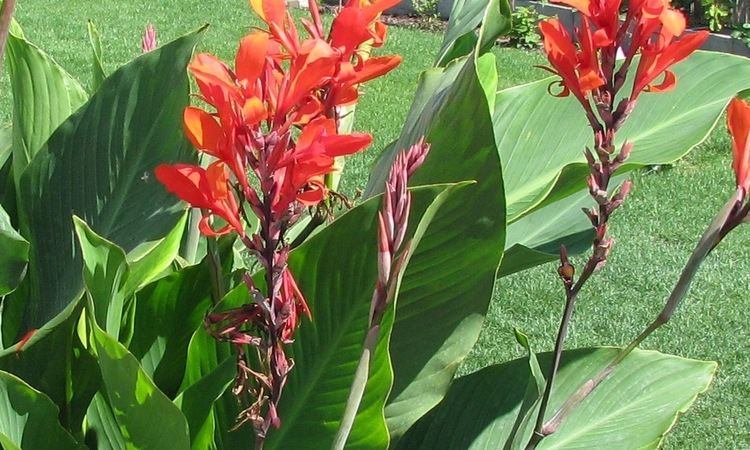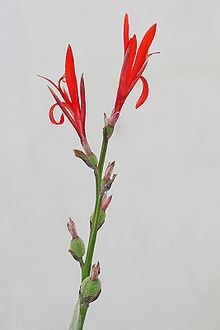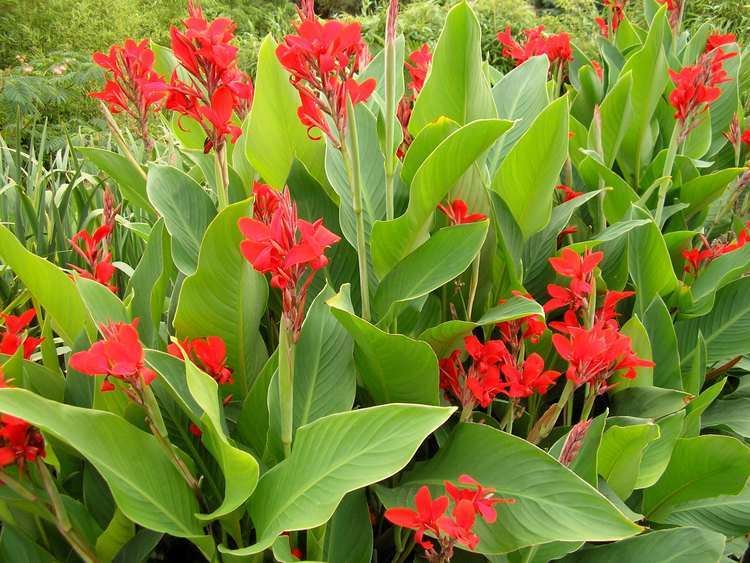Family Cannaceae Rank Species | Genus Canna Higher classification Canna | |
 | ||
Similar Canna, Cannaceae, Canna ×generalis, Iris tectorum, Purple‑loosestrife | ||
Canna indica plants from seed day 0 12th feb 2015
Canna indica, commonly known as Indian shot, African arrowroot, edible canna, purple arrowroot, Sierra Leone arrowroot, is a plant species in the family Cannaceae. It is native to much of South America, Central America, the West Indies, Mexico, and the southeastern United States (Florida, Texas, Louisiana, and South Carolina). It is also naturalized in much of Europe, sub-Saharan Africa, Southeast Asia, and Oceania.
Contents
- Canna indica plants from seed day 0 12th feb 2015
- Canna indica from seed to seedling
- Seeds
- Taxonomy
- As food
- Prehistoric domestication
- References
Canna indica is a perennial growing to between 0.5 m and 2.5 m, depending on the variety. It is hardy to zone 10 and is frost tender. The flowers are hermaphrodite. Canna indica sps. can be used for the treatment of industrial waste waters through constructed wetlands. It is effective for the removal of high organic load, color and chlorinated organic compounds from paper mill wastewater.

Canna indica (achira in Latin America) has been a minor food crop cultivated by indigenous peoples of the Americas for thousands of years.

Canna indica from seed to seedling
Seeds

The seeds are small, globular, black pellets, hard and dense enough to sink in water. They resemble shotgun pellets giving rise to the plant's common name of Indian shot. The seeds are hard enough to shoot through wood and still survive and later germinate. According to the BBC "The story goes that during the Indian Mutiny of the 19th century, soldiers used the seeds of a Canna indica when they ran out of bullets."

The seeds are widely used for jewellery. The seeds are also used as the mobile elements of the kayamb, a musical instrument from Réunion, as well as the hosho, a gourd rattle from Zimbabwe, where the seeds are known as "hota" seeds.
Taxonomy
In the last three decades of the 20th century, Canna species have been categorised by two different taxonomists, Paulus Johannes Maria Maas from the Netherlands and Nobuyuki Tanaka from Japan. Maas regards C. coccinea, C. compacta, C. discolor, C. patens and C. speciosa as synonyms or varieties of C. indica, while Tanaka recognises several additional varieties of C. indica.
As food
The C. indica (achira) rhizomes are large, up to 60 centimetres (24 in) in length, and edible. They can be eaten raw, but are usually baked. Cooked, the rhizomes become translucent, mucilaginous, and sweet. Starch is produced by grinding or pounding the roots and soaking them in water, separating the starch granules from fibers in the roots. The starch granules of C. indica are also translucent and the largest known from any plant. The starch is occasionally marketed commercially as "arrowroot", a name also applied to the starch of other similar roots crops such as Maranta arundinacea. It was an ingredient in mid-nineteenth century recipes such as cakes and was called tout-les-mois.
The Spanish took notice of achira in 1549 when it was mentioned as one of four root crops being grown for food by the people of the Chuquimayo valley (Jaén province) of Peru. The other three were sweet potato (Ipomoea batatas), cassava (Manihot esculenta), and racacha (Arracacia xanthorrhiza). In 1609, achira was described by a Spanish visitor to Cusco, Peru. In modern times, achira is rarely grown for food, although in the 1960s it was still an important crop in Paruro Province on the upper Apurimac River near Cusco. There, at elevations of up to 2,600 metres (8,500 ft), achira is cultivated and harvested, especially to be eaten during the Festival of Corpus Christi in May or June. The achira rhizomes are wrapped with achira leaves and placed in a pit with heated rocks. The pit is then filled with dirt and the achira is slowly baked underground.
Prehistoric domestication
Canna indica (achira) has been cultivated by indigenous peoples of the Americas in tropical America for thousands of years. The place of the first domestication may have been the northern Andes, as may be true of other similar root crops such as Calathea allouia and M. arundinacea. The Cauca river valley of Colombia was a center of early domestication. Archaeological evidence has been found of the cultivation of achira in 3000 BCE by people of the Las Vegas culture of coastal Ecuador. As the Las Vegas region is arid and semi-arid, achira was not likely a native plant, but imported from more humid climates. Achira was also being cultivated by 2000 BCE by the people of the Casma/Sechin culture in the extremely arid region of coastal Peru, also an area in which achira was probably not native.
In modern times, C. indica is reportedly naturalized in Austria, Portugal, Spain, Azores, Canary Islands, Cape Verde, Madeira, most of tropical Africa, Ascension Island, St. Helena, Madagascar, China, Japan, Taiwan, the Bonin Islands, India, Nepal, Sri Lanka, Cambodia, Laos, Thailand, Vietnam, Burma, Java, Malaysia, the Philippines, Christmas Island, the Bismarck Archipelago, Norfolk Island, New South Wales, Queensland, Fiji, Tonga, Vanuatu, Kiribati, the Cook Islands, the Society Islands, the Caroline Islands and Hawaii.
